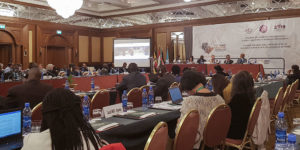
The last Regional Consultative Process (RCP) of the Intergovernmental Authority on Development (IGAD), held in October 2019 in Addis Ababa and co-convened by GP20, was exclusively dedicated to internal displacement. With over a 100 government officials, humanitarian and development practitioners, donors and other actors, the event was a great opportunity to hear directly from IGAD member states about their different approaches and experiences in addressing the phenomenon. I particularly enjoyed the rich exchanges and discussions with participants, including during the working group session we co-facilitated together with ReDSS and IDMC, on “data collection and information management regarding durable solutions to internal displacement”.
Two elements in particular, were highlighted across the board of the two-day event: the importance of area-based approaches for effective solutions that embrace the complexity of a displacement situation, and of working at the nexus between humanitarian, development, peacebuilding and government actors. Both are also emphasised in the preliminary recommendations from the event, and increasingly reflected in durable solutions analysis praxis. Let’s dive deeper into these topics:
Effectively informing area-based solutions requires an area-based approach to durable solutions analysis (1) that utilises a defined spatial area as the entry point for understanding the characteristics and conditions of the target populations as well as those of the areas hosting them. Such analysis acknowledges in particular, that it is not possible to comprehensively analyse how a displaced population is progressing towards solutions without taking into account the following elements:
With displacement becoming increasingly urbanised, an area-based analysis approach that looks at both people and places can be particularly useful in urban displacement situations, as it helps achieve a more comprehensive understanding of the often multi-facetted impact of displacement on people and places in a city, as well as the diverse factors and dynamics that influence solutions.
The IGAD event reiterated a key point made at several recent global events (such as UNHCR’s NGO Consultations 2019, the latest GP20 Steering Group meeting, and the ECOSOC Humanitarian Affairs Segment):
“The conference validated the whole-of-government, whole-of-society and multi-sector approach to achieve durable solutions.”
What does this mean in practice, for data and analysis on solutions? One key recommendation that came out from the working group on data that we co-facilitated, was the importance of government leadership in solutions analysis. Participants specifically highlighted the critical role of local authorities for a detailed analysis of the services, infrastructure, housing and land in a given city. For instance, the earlier-mentioned example of housing solutions in Baidoa (Somalia), would not have been possible without the leadership of local authorities.
Furthermore, having government actors in the driving seat can also facilitate the integration of solutions analysis into existing national level data collection systems such as censuses, socio-economic studies, etc. – something participants of the working group considered key to progressing towards sustainable solutions to displacement. In Somalia, for example, a government-led profiling exercise in Mogadishu resulted in the integration of durable solutions to internal displacement into the national development plan, and in Ethiopia the next census will include data on displacement.
However, as participants emphasised during the data working group session, this calls for a focus on capacity development amongst national actors, to enhance national data collection systems and better include IDP statistics. The International Recommendations on IDP Statistics and related operational manual, that are being developed through the Expert Group on Refugees and IDP Statistics (EGRIS) and will be submitted to the UN Statistical Commission in March 2020 for endorsement, will be useful tools in this context. EGRIS is working closely with national statistics authorities – including from IGAD member states Uganda, Somalia, Djibuti, Kenya and Ethiopia – to ensure strong linkages with national planning, budgeting and policy processes.
This furthermore reiterates the call for a shift in mindsets and more collaborative approaches that bring together analysis of more immediate conditions and humanitarian needs, with that of longer-term socio-economic factors such as livelihoods strategies and capacities, community dynamics, cohesion and participation in public affairs, etc. In JIPS we have been investing in improving profiling approaches in this sense. A recent example is the exercise in Darfur (Sudan), where the government together with the UN Country Team and the World Bank conducted a durable solutions analysis, which looked both at vulnerabilities and humanitarian needs, while also focusing very much on livelihoods, access to services, capacities, coping strategies, civic engagement and longer term plans.
As keynote speakers Professor Walter Kaelin and Dr. Mehari Tadelle Maru highlighted in their concluding remarks, there is no one-size-fits-all approach when it comes to solutions for IDPs. Informing effective solutions policies and responses is a complex undertaking that requires consideration of various conditions within the specific displacement situation. In addition, “not all solutions need to be durable”, as Professor Kaelin emphasised, meaning that in cases where sustainable solutions are not feasible yet, working to reduce key displacement-related vulnerabilities still remains critical and helps to pave the way.
I am looking forward to the final recommendations from the IGAD event, which also aim to inform the African Union’s Project 2019 and feed into the African Union`s Project 2019 Commemorative Continental Meeting on the Kampala Convention in December 2019.
(1) For more on area-based approaches check out these and other background materials: Urban Profiling for Better Responses to Humanitarian Crises (2019), What’s missing? Adding Context to the Urban Response Toolbox (2018), Displaced in Cities: Challenging assumptions on urban displacement (2018), to name a few.